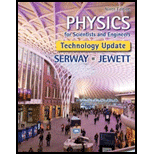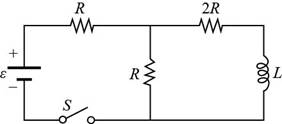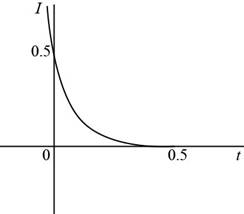
Concept explainers
(a)
The inductor behaves like an open circuit or short circuit or a resister of some particular resistance or none of those choices before the switch is opened.
(a)
Answer to Problem 32.64AP
Explanation of Solution
Given info: The induced voltage is 10.0 V, the resistance of the resistor is 4.00 Ω and the inductance of the inductor is 1.00 H.
The inductor has no resistance. If the switch is closed for a long time, then inductor will reach saturation and voltage passes through the inductor. Hence, it behaves as a short circuit.
Conclusion:
Therefore, the inductor behaves as the short circuit because of no resistance.
(b)
The current carried by the inductor.
(b)
Answer to Problem 32.64AP
Explanation of Solution
Given info: The induced voltage is 10.0 V, the resistance of the resistor is 4.00 Ω and the inductance of the inductor is 1.00 H.
The figure of the circuit diagrammed referred from P31.15 is shown below.

Figure (1)
The net resistance for parallel combination is,
1R'=1R+12RR'=2R3
Here,
R' is the net resistance for parallel combination.
R is the resistance of the circuit.
The net resistance is connected in series with R for parallel combination is,
Rnet=R+R' (1)
Here,
Rnet is the net resistance is connected in series.
Substitute 2R3 for R' in equation (1).
Rnet=R+2R3 (2)
Substitute 4.00 Ω for R in equation (2) to find the Rnet.
Rnet=4.00 Ω+2(4.00 Ω)3=6.67 Ω
Formula to calculate the current of battery is,
Ib=εRnet
Here,
Ib is the battery current.
ε is the induced voltage.
Substitute 10.0 V for ε and 6.67 Ω for Rnet in equation (3) to find the Ib.
Ib=10.0 V6.67 Ω=1.499 A≈1.50 A
The voltage across the parallel combination of resistors is,
V=ε−IbR (6)
Substitute 1.50 A for Ib, 10.0 V for ε and 4.00 Ω for R in equation (6) to find the V.
V=10.0 V−(1.50 A)(4.00 Ω)=4.00 V
Formula to calculate the current though the inductor is,
Ii=V2R (7)
Substitute 4.00 V for V and 4.00 Ω for R in equation (7) to find the Ii.
Ii=4.00 V2(4.00 Ω)=0.500 A
Conclusion:
Therefore, the current carried by the inductor for t<0 is 0.500 A.
(c)
The energy stored in the inductor.
(c)
Answer to Problem 32.64AP
Explanation of Solution
Given info: The induced voltage is 10.0 V, the resistance of the resistor is 4.00 Ω and the inductance of the inductor is 1.00 H.
Formula to calculate the energy stored in the inductor is,
Ui=12LIi2
Substitute 1.00 H for L and 0.500 A for Ii to find the Ui.
Ui=12(1.00 H)(0.500 A)2=0.125 J
Thus, the energy stored in the inductor for t<0 is 0.125 J.
Conclusion:
Therefore, the energy stored in the inductor for t<0 is 0.125 J.
(d)
The energy previously stored in the inductor after the switch is opened.
(d)
Answer to Problem 32.64AP
Explanation of Solution
Given info: The induced voltage is 10.0 V, the resistance of the resistor is 4.00 Ω and the inductance of the inductor is 1.00 H.
When switch is opened, the energy stored in the inductor will dissipate through resistor R and 2R. Thus, the energy becomes 0.125 J of the additional internal energy in the R and 2R. in the middle branch.
Conclusion:
Therefore, the energy becomes 0.125 J of the additional internal energy in the R and 2R. in the middle branch after switch is opened.
(e)
To draw: The graph of the current in the inductor for t≥0 with the initial and final values and the time constant.
(e)
Answer to Problem 32.64AP
Answer The graph of the current in the inductor for t≥0 and label the initial and final values and the time constant.

Explanation of Solution
Introduction:
The graph of the current verses time shows the variation of the current in the circuit with time and tells the nature of the current.
Explanation:
Given info: The induced voltage is 10.0 V, the resistance of the resistor is 4.00 Ω and the inductance of the inductor is 1.00 H.
After time t=0, the resistance of the circuit will be,
R1=R+2R=3R
Formula to calculate the time constant is,
t=LR1 (8)
Substitute 3R for R1 and 1.00 H for L to find the t.
t=1.00 H3R (9)
Substitute 4.0 Ω for R in equation (9) to find the t.
t=1.00 H3×4.0 Ω=0.083 s
The current flowing through the inductor at time t is,
I=I0e−RLt
Substitute 0.500 A for I0 and 12.0 Ω for R1 and 0.083 s for t in equation (10).
I=(0.500 A)e−(12.0 Ω)1.0 H(0.083 s)
Thus, the graph of the current (the initial and final values) in the inductor for t≥0 and the time constant from equation (11) is shown below.

Figure (2)
The graph shows that current decays with exponentially with time constant. The current decreases from 0.500 A towards zero because time constant goes to zero so, the final value of the current gets zero.
Want to see more full solutions like this?
Chapter 32 Solutions
Physics for Scientists and Engineers, Technology Update (No access codes included)
- Explain why Ampere’s law can be used to find the magnetic field inside a solenoid but not outside.arrow_forward3. An Atwood machine consists of two masses, mA and m B, which are connected by an inelastic cord of negligible mass that passes over a pulley. If the pulley has radius RO and moment of inertia I about its axle, determine the acceleration of the masses mA and m B, and compare to the situation where the moment of inertia of the pulley is ignored. Ignore friction at the axle O. Use angular momentum and torque in this solutionarrow_forwardA 0.850-m-long metal bar is pulled to the right at a steady 5.0 m/s perpendicular to a uniform, 0.650-T magnetic field. The bar rides on parallel metal rails connected through a 25-Ω, resistor (Figure 1), so the apparatus makes a complete circuit. Ignore the resistance of the bar and the rails. Please explain how to find the direction of the induced current.arrow_forward
- For each of the actions depicted, determine the direction (right, left, or zero) of the current induced to flow through the resistor in the circuit containing the secondary coil. The coils are wrapped around a plastic core. Immediately after the switch is closed, as shown in the figure, (Figure 1) in which direction does the current flow through the resistor? If the switch is then opened, as shown in the figure, in which direction does the current flow through the resistor? I have the answers to the question, but would like to understand the logic behind the answers. Please show steps.arrow_forwardWhen violet light of wavelength 415 nm falls on a single slit, it creates a central diffraction peak that is 8.60 cm wide on a screen that is 2.80 m away. Part A How wide is the slit? ΟΙ ΑΣΦ ? D= 2.7.10-8 Submit Previous Answers Request Answer × Incorrect; Try Again; 8 attempts remaining marrow_forwardTwo complex values are z1=8 + 8i, z2=15 + 7 i. z1∗ and z2∗ are the complex conjugate values. Any complex value can be expessed in the form of a+bi=reiθ. Find θ for (z1-z∗2)/z1+z2∗. Find r and θ for (z1−z2∗)z1z2∗ Please show all stepsarrow_forward
- Calculate the center of mass of the hollow cone shown below. Clearly specify the origin and the coordinate system you are using. Z r Y h Xarrow_forward12. If all three collisions in the figure below are totally inelastic, which will cause more damage? (think about which collision has a larger amount of kinetic energy dissipated/lost to the environment? I m II III A. I B. II C. III m m v brick wall ע ע 0.5v 2v 0.5m D. I and II E. II and III F. I and III G. I, II and III (all of them) 2marrow_forwardCan you solve this 2 question teach me step by step and draw for mearrow_forward
- From this question and answer can you explain how get (0,0,5) and (5,0,,0) and can you teach me how to solve thisarrow_forwardCan you solve this 2 question and teach me using ( engineer method formula)arrow_forward11. If all three collisions in the figure below are totally inelastic, which brings the car of mass (m) on the left to a halt? I m II III m m ע ע ע brick wall 0.5v 2m 2v 0.5m A. I B. II C. III D. I and II E. II and III F. I and III G. I, II and III (all of them)arrow_forward
 Physics for Scientists and Engineers, Technology ...PhysicsISBN:9781305116399Author:Raymond A. Serway, John W. JewettPublisher:Cengage Learning
Physics for Scientists and Engineers, Technology ...PhysicsISBN:9781305116399Author:Raymond A. Serway, John W. JewettPublisher:Cengage Learning Principles of Physics: A Calculus-Based TextPhysicsISBN:9781133104261Author:Raymond A. Serway, John W. JewettPublisher:Cengage Learning
Principles of Physics: A Calculus-Based TextPhysicsISBN:9781133104261Author:Raymond A. Serway, John W. JewettPublisher:Cengage Learning Physics for Scientists and EngineersPhysicsISBN:9781337553278Author:Raymond A. Serway, John W. JewettPublisher:Cengage Learning
Physics for Scientists and EngineersPhysicsISBN:9781337553278Author:Raymond A. Serway, John W. JewettPublisher:Cengage Learning Physics for Scientists and Engineers with Modern ...PhysicsISBN:9781337553292Author:Raymond A. Serway, John W. JewettPublisher:Cengage Learning
Physics for Scientists and Engineers with Modern ...PhysicsISBN:9781337553292Author:Raymond A. Serway, John W. JewettPublisher:Cengage Learning Physics for Scientists and Engineers: Foundations...PhysicsISBN:9781133939146Author:Katz, Debora M.Publisher:Cengage Learning
Physics for Scientists and Engineers: Foundations...PhysicsISBN:9781133939146Author:Katz, Debora M.Publisher:Cengage Learning College PhysicsPhysicsISBN:9781285737027Author:Raymond A. Serway, Chris VuillePublisher:Cengage Learning
College PhysicsPhysicsISBN:9781285737027Author:Raymond A. Serway, Chris VuillePublisher:Cengage Learning





